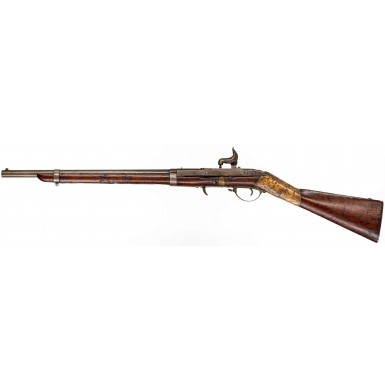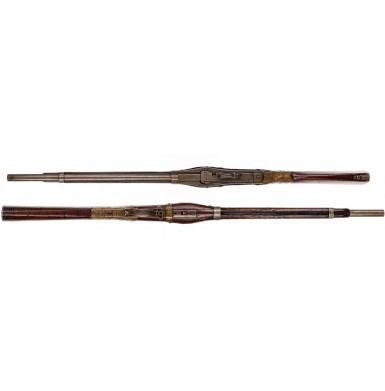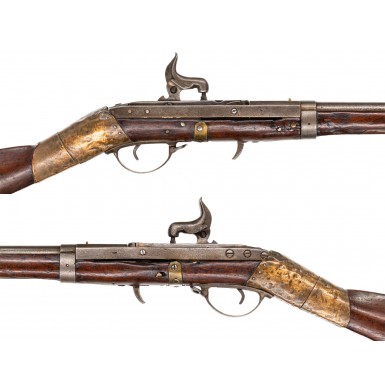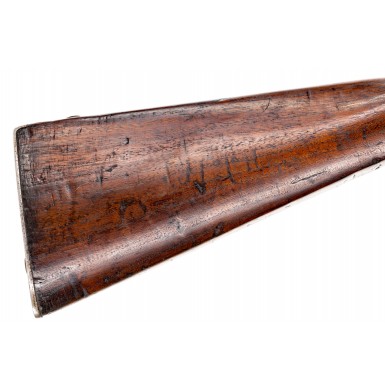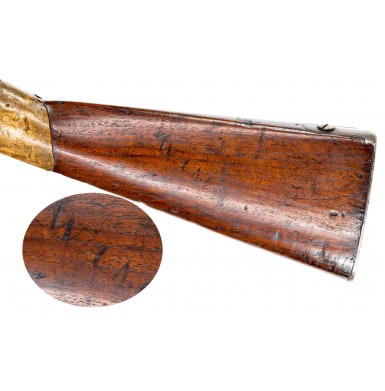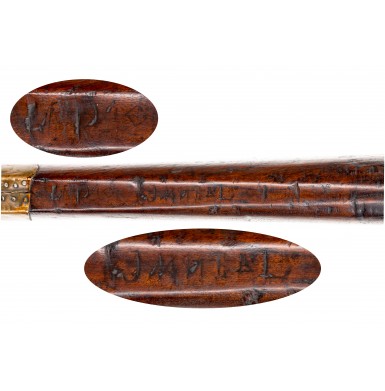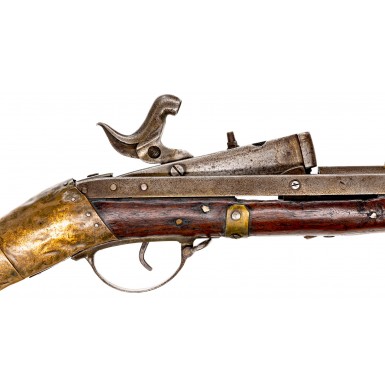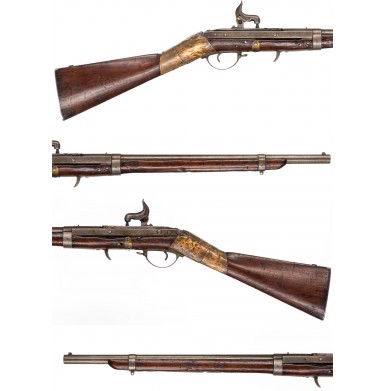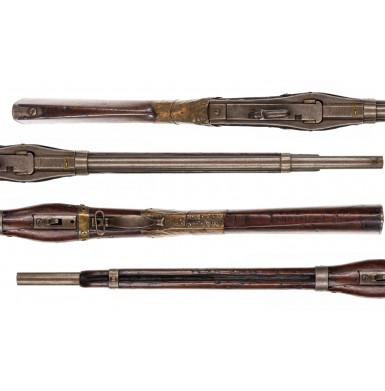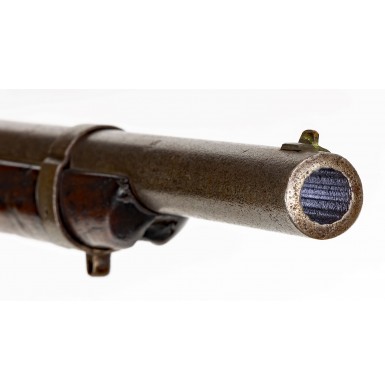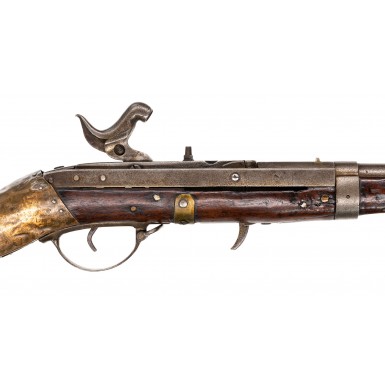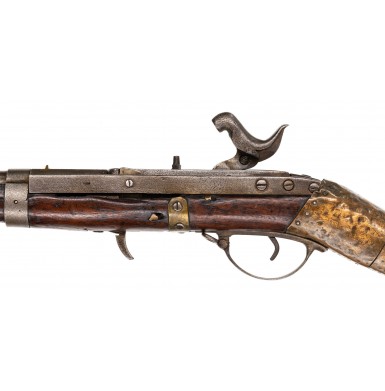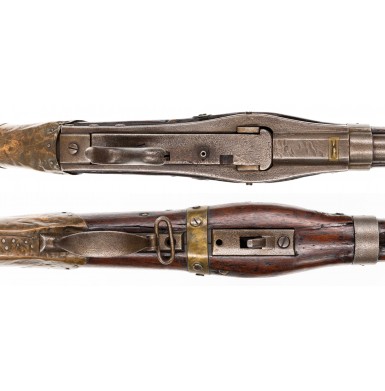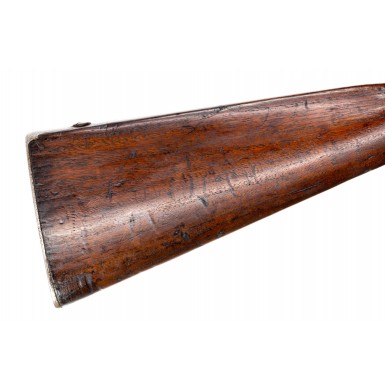Extremely Rare Confederate Jackson Mississippi Altered Hall Rifle Converted to Cavalry Carbine
- Product Code: FLA-3968
- Availability: Out Of Stock
-
$6,500.00
Sometimes lighting strikes twice, and I am very pleased to offer this very interesting and extremely rare example of a Confederate percussion altered Hall rifle, converted to a cavalry carbine. What is amazing is that I have had another example of this incredibly scarce gun before, and like that one, this one has a number of carved initials, as well as a partially legible name, which may allow it to be fully identified.
It is nearly impossible to understate the actual rarity of this firearm. To my knowledge, only about a half dozen or so are known to exist. Two of them are in the collection of the late Dr. John Murphy, which are in the collection of (and were formerly on display at) the Greensboro Historical Society in North Carolina. I had the opportunity to sell another of the known examples in private hands about 15 years ago. That one “came out of the bushes” in northern Mississippi. This one surfaced from an old estate collection from Florida in 2013 and I sold it at that time. I now have the honor to sell it again. Dr. Murphy clearly documented his two specimens in the seminal work Confederate Carbines & Musketoons that he wrote with the assistance of the late Howard Michael (“Howie”) Madaus. The twins to this “carbine” are pictured on pages 201-203 of that book.
The conversion to percussion performed on this gun is quite unique, and due to the extensive research of Murphy & Madaus, we know that these conversions were performed at the Mississippi State Arsenal in Jackson, MS. The Hall rifles that were converted and altered at the arsenal in Jackson were shipped from the US Arsenal in Baton Rouge, LA in early 1861, after Louisiana had succeeded from the Union. Baton Rouge had 2,287 Hall flintlock rifles in their stores in October of 1860, and 1,000 of those arms were sent to Mississippi. According to Murphy & Madaus, most of these rifles were altered to percussion between July and August of 1861 and were issued to Mississippi infantry regiments by September of that year. However, they note that a small number of these rifles were not only percussion converted, but also altered to carbine length for use by Mississippi State mounted troops.
According to their research, these Hall “carbines” were subsequently issued to the 1st Mississippi Cavalry. The Halls altered in Jackson have some very specific characteristics that make them immediately identifiable. In nearly all cases of Confederate Hall rifle alterations to percussion, the breechblock was milled completely flat after the removal of the flintlock battery. This usually removed the original breechblock markings. Prior to the milling of the block, the recess in the top of the breechblock that allowed for the movement of the toe of the frizzen was typically filled. On the Mississippi State Arsenal alterations this recess was left unfilled during the conversion process, and sometimes the markings remain partially legible. Additionally, the percussion cone (nipple) was installed at a 90° angle to the breechblock, directly into the original flintlock touchhole. On nearly all other CS conversions, the cone is set at an angle to the breechblock. The profile of the percussion hammer is also unique to these conversions. The original hammer was cut through the center of the throat hole and a new striker with a very distinctive thumb piece or spur, which Murphy calls is a “squirrel tail”, was brazed onto the original bottom portion of the hammer. During the alteration the left side of the breechblock was marked with an Arabic number. A matching mating number was struck on the right side of the stock, just behind the wrist. In the book one of the two examples is pictured marked with conversion reassembly number 13 on the block. On this example there is an extremely weak mating number on the left side of the breech block, which appears to be a 5 but which can only be seen with the right light and at the right angle with magnification. This is due to the pitting in the metal, into which the marking blends almost completely. Due to the sheet brass used to reinforce a wrist repair, no mating number is visible in the wood. As part of the alteration the barrels of the guns were shortened to “carbine length”. On this example the barrel is 21 ½”, giving the gun an overall length of 41 3/8”. The two examples in the Murphy collection each have different barrel lengths, one is 21 ¾” long and the other is 22 ½” long. The barrels were cut off flush with the muzzle, and the original .52 caliber bore with sixteen ands and grooves were retained during the alteration process. The original middle barrel band has been retained on this example, with a portion of the original rifle forend removed. The part retained has been rounded and contoured into a new forend tip. The original rear sights were typically retained during the alteration process, on the top of the breechblock, and new front sights were installed at the end of the barrel. On this example the rear sight is a very old, period of use fixed brass block sight with the distinctive Hall offset sighting notch necessary to sight around the hammer of the gun. The front sight is a dovetailed brass blade and base that is also appropriately offset.
According to Dr. Murphy’s research at least two full-length rifles have been documented with the exact same style of alteration to percussion. The number of surviving rifles known with this alteration is estimated at less than ten.
The even more intriguing part of the gun is the fact that it has multiple sets of initials as well as a partial name, which might make it possible to positively identify the members of the 1st Mississippi Cavalry who may have carried this carbine. Since it has been documented that these Mississippi State Arsenal altered carbines were issued to the 1st MS Cavalry, the initials provide the ability to compare them to the roster of soldiers that served in that unit. The initials H T H(or possibly J I T H) appear on the obverse buttstock of the carbine. Initials that appear to read J M P are carved into the flat toe line of the stock, behind the triggerguard, and a name that appears to read J M PEAT (or possibly “PEAT”) is carved into the toe line further back than the initials. The reverse buttstock is carved diagonally with the letters that appear to read W A N. The “HTH” initials may be those of H T Horn, who served in Company D of the 1st Mississippi Cavalry. The “JMP” initials might be J M Parks (who served in Company B of the 1st MS cavalry), although “Parks” does not appear to match the partially legible portion of the last name after the initials. It could also be James M Plank (Company I) but again the last name does not quite line up with the letters that appear legible in the last name. A J A Peale did serve the state of Mississippi in the “conscript infantry”, so it is possible that it saw service with him after doing service with the cavalry. As the gun shows heavy use and rather extensive period repairs, it may not have been considered a viable cavalry weapon anymore and was issued to an infantry conscript. Several other possible identifications exist with the first initial “J”, a last name starting with “P”, but with no middle initial listed in the records. If any of these carvings can be more specifically narrowed down and interpreted, it might be possible to find one or more of the soldiers who carried and handled the gun while serving with the 1st Mississippi Cavalry.
The 1st Mississippi Cavalry under the command of Colonel Andrew Lindsay, and later R.A. Pinson were heavily involved in most of the major western theater battle action from the beginning to the end of the war. Their first major action was at the Battle of Belmont on 7 November 1861. This rather small engagement would later be remembered as Union General Ulysses Grant’s first victory. They were subsequently at Madrid Bend and Island No 10, where they managed to escape prior to the surrender of that garrison to Grant. The 1st Mississippi Cavalry was further engaged on 6 April 1862 at the battle of Shiloh where they captured Ross’s Michigan Battery, including four guns and twenty-seven men. The regiment was further engaged in Western Middle Tennessee at the Battle of Britton’s Lane on September 1, 1862, and then served during the campaign and siege of Corinth, MS. The regiment spent most of early 1863 in Middle Tennessee, skirmishing in and around Spring Hill and Thompsons Station. During 1864 the regiment was brigaded with the 2nd, 28th & Ballentine’s Mississippi Regiment to form General Armstrong’s brigade of cavalry and fought through the entire Atlanta campaign. At the battle in Dallas, GA on 28 May 1864 they repeated their Shiloh success by again capturing four artillery pieces. Following the failed Atlanta Campaign, the brigade, under the overall command of Nathan Bedford Forrest returned to Middle Tennessee and were engaged at Spring Hill, TN on 29 November 1864 and the next day at the Battle of Franklin, where they crossed the Harpeth River and “attacked the enemy strongly posted on a hill”. For those familiar with the Franklin area, this was almost certainly Fort Granger. After the Battle of Franklin, the 1st Mississippi Cavalry moved to Brentwood and Nashville until the infantry came up, at which point Forrest took them to siege Murfreesboro, TN. After the Battle of Nashville, they served under Forrest as part of the rear guard that protected Hood’s retreating army and fought in a number of small actions between December 23 and 26, 1864. The 1st Mississippi remained with Forrest until the very end, serving valiantly at the Battle of Selma, AL and finally surrendering with Forrest on 22 May 1865 in Gainesville, AL.
This very rare Mississippi State Arsenal altered Hall carbine to rifle rates about GOOD+ overall condition. The carbine is essentially complete, with the exception of the “ramrod” or cleaning rod, the upper sling swivel, and the skeletonized pistol grip section of the triggerguard. There is one triggerguard mounting screw missing from the front of the triggerguard and one from the rear of the block release mounting plate. A couple of the action screws appear to be old replacements as well. As previously mentioned, the rear sight is a brass blade that appears to be a period replacement, and the front sight is a similar brass blade on a brass base. Both appear to be from the period of use and have a dark, thickly oxidized and completely untouched patina. The metal of the gun has a fairly even medium pewter gray patina, with evenly scattered darker oxidized peppering over all of the surfaces. The metal is evenly pitting throughout which appears to be the result of both period use and later poor storage. The pitting, combined with the milling that was part of the Confederate modifications to the breech block have completely obscured any of the original Harper’s Ferry markings on the top of the gun. As previously noted the reassembly mating mark 5 on the left side of the breech block is almost completely concealed by pitting and if there were one on the rear of the wrist, the period repairs have covered it. The action of the carbine works exactly as it should. The breechblock release functions correctly and the block locks in place tightly. The hammer still operates on both half and full cock and responds to the trigger as it should. The triggerguard is altered and the rear-most skeletonized pistol grip section has been removed. This may have been the result of damage to the stock, as the wrist of the gun is wrapped with a period copper sheeting to reinforce the stock in this region. The bore of the carbine retains the deep and sharp multi-groove Hall patent rifling. The bore is dark and dirty, heavily oxidized and shows even pitting throughout. The stock of the carbine is in GOOD condition and shows significant wear and a significant number of period repairs and modifications. As previously noted, the wrist is wrapped with copper that is nailed in place with small finishing nails, an apparent attempt to repair and reinforce this area. There is also a small brass strap nailed and screwed onto the bottom of the stock as reinforcement between the triggerguard and the breechblock release. The portion of the stock, just forward of the rear barrel band shows heavy wear commensurate with having been carried over the pommel of a saddle for a significant amount of time. The stock also has a number of small cracks, as well as a number of gouges, deeps dings and nicks in the wood. All of this wear is typical of a Confederate saddle gun that has seen lots of field use. The extensive wear and the numerous field repairs make the carbine even more attractive and give it a fantastic “southern” look. At some point the wood was lightly sanded and this is what has smeared the carved letters, making them less clear and difficult to interpret.
This is one of those guns that simply needs no additional spin or story to make it a wonderful example of a Confederate altered and used Civil War firearm. This carbine has a number of things going for it. First, it is one of only a handful of examples of this gun known to exist. At the time it first surfaced it was only the fourth one known and only the second one in private hands. Second, it is potentially identifiable to one (or possibly as many as three) members of 1st Mississippi Cavalry, due to the initials and names carved into the stock. Third, it is a wonderful field-used example of an incredibly rare Confederate Hall alteration with great documentation as to where it was altered to a to which regiment it was issued. This gun could clearly be the centerpiece of any serious Confederate Civil War collection, especially one that centered on identified weapons, arms of the Confederate Cavalry or Mississippi related items. It would also be a fantastic addition to an advanced collection of Confederate made and altered carbines and musketoons. This gun would be equally at home in any collection that centered on the many battles and skirmishes that it might have been involved in from Shiloh to Franklin. This is one of those rare opportunities to own an example of a Confederate long arm that might not be available again for many years to come.
ON HOLD / LAYAWAY
Tags: Extremely, Rare, Confederate, Jackson, Mississippi, Altered, Hall, Rifle, Converted, to, Cavalry, Carbine



